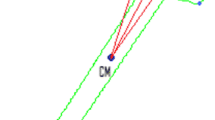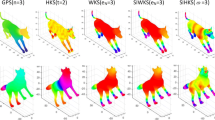Abstract
Dynamic space warping (DSW) has emerged as a very effective tool for matching shapes. However, a central computational difficulty associated with DSW arises when a boundary’s starting point (or rotation angle) is unknown. In this article, the HopDSW algorithm is proposed to speed up the starting point computation. Rather than performing an exhaustive search for the correct starting point as in classical approaches, the proposed algorithm operates in a coarse-to-fine manner. The coarse search is global and uses a hopping step to exclude points from the search. Then the search is refined in the neighborhood of the solution of the coarse search. A criterion that governs selecting the hopping step parameter is given, which reduces the number of starting point computations by an order. For shape representation, a triangle area signature (TAS) is computed from triangles formed by the boundary points. Experimental results on the MPEG-7 CE-1 database of 1400 shapes show that the proposed algorithm returns the solution to an exhaustive search with a high degree of accuracy and a considerable reduction in the number of computations.
Similar content being viewed by others
References
Kunttu I, Lepisto L (2007) Shape-based retrieval of industrial surface defects using angular radius Fourier descriptor. IET Image Process 1(2):231–236
Jain AK, Vailaya A (1998) Shape-based retrieval: a case study with trademark image databases. Pattern Recognition 31(9):1369–1390
Pentland A, Picard R, Sclaro S (1996) Photobook: content-based manipulation of image databases. Int J Comput Vision 18(3): 233–254
Alajlan N, Elrube I, Kamel MS, et al (2007) Shape retrieval using triangle-area representation and dynamic space warping. Pattern Recognition 40:1911–1920
Deller J, Hansen J, Proakis J (1999) Discrete-time processing of speech signals. Wiley-IEEE, reprint edn
Itakura F (1975) Minimum prediction residual principle applied to speech recognition. IEEE Trans Acoustics Speech Signal Process 23:52–72
Sakoe H, Chiba S (1978) Dynamic programming algorithm optimization for spoken word recognition. IEEE Trans Acoustics Speech Signal Process 26:43–49
Adamek T, O’Connor N (2004) A multiscale representation method for nonrigid shapes with a single closed contour. IEEE Trans Circuits Syst Video Tech 14(5):742–753
Bartolini I, Ciaccia P, Patella M (2005) Warp: accurate retrieval of shapes using phase of Fourier descriptors and time-warping distance. IEEE Trans Pattern Anal Mach Intel 27(1):142–147
Ling H, Jacobs D (2005) Using the inner distance for classification of articulated shapes. IEEE International Conference on Computer Vision and Pattern Recognition, vol 2, pp 719–726
Petrakis EGM, Diplaros A, Milios E (2002) Matching and retrieval of distorted and occluded shapes using dynamic programming. IEEE Trans Pattern Anal Mach Intel 24(11):1501–1516
Ratanamahatana C, Keogh E (2005) Three myths about dynamic time warping data mining. International Conference on Data Mining, pp 506–510
Salvador S, Chan P (2004) FastDTW: toward accurate dynamic time warping in linear time and space. KDD Workshop on Mining Temporal and Sequential Data, pp 70–80
Keogh E, Wei L, Xi X, et al (2006) LB_Keogh supports exact indexing of shapes under rotation invariance with arbitrary representations and distance measures. Proceedings of the 32nd International Conference on Very Large Databases, pp 882–893
Ip HHS, Shen DG (1998) An affine-invariant active contour model (ai-snake) for model-based segmentation. Image Vision Comput 16(2):135–146
Roh K, Kweon I (1998) 2-D object recognition using invariant contour descriptor and projective refinement. Pattern Recognition 31(4):441–445
Pratt WK (1991) Digital image processing. Wiley, 2nd edn
Latecki LJ, Lakamper R, Eckhardt U (2000) Shape descriptors for non-rigid shapes with a single closed contour. IEEE Conference on Computer Vision and Pattern Recognition, pp 424–429
Alajlan N (2008) http://faculty.ksu.edu.sa/naifajlan/pages/activities.aspx
Author information
Authors and Affiliations
Corresponding author
Additional information
This work was presented in part and was awarded the Young Author Award at the 15th International Symposium on Artificial Life and Robotics, Oita, Japan, February 4–6, 2010
About this article
Cite this article
Alajlan, N. Fast shape matching and retrieval based on approximate dynamic space warping. Artif Life Robotics 15, 309–315 (2010). https://doi.org/10.1007/s10015-010-0814-7
Received:
Accepted:
Published:
Issue Date:
DOI: https://doi.org/10.1007/s10015-010-0814-7




